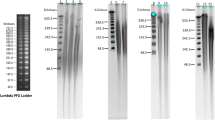Abstract
A subtractive hybridization method is described that allows the generation of a subtractive gene library from small amounts of plant or other eukaryotic tissues. The method uses paramagnetic oligo-dT beads to capture poly-adenylated mRNA and to synthesize the complementary cDNA on a solid support. The use of magnetic beads facilitates the change of reaction buffers and the removal of primers and minimizes yield losses. Subtracted material obtained from this method can either be cloned directly or used to screen a specific library.
Similar content being viewed by others
References
Hara, E., Kato, T., Nakada, S., Sekija, S., and Oda, K. (1991) Subtractive cDNA cloning using oligo(dT)30-latex and PCR: isolation of cDNA clones specific to undifferentiated human embryonal carcinoma cells.Nucleic Acids Res. 19, 7097–7104.
Swaroop, A., Xu, J., Agarwal, N., and Weissman, S. M. (1991) A simple and efficient cDNA library subtraction procedure: isolation of human retina-specific cDNA clones.Nucleic Acids Res. 19, 1954.
Raineri, I., Moroni, C. and Senn, H. P. (1991) Improved efficiency for single-sided PCR by creating a reusable pool of first-strand cDNA coupled to a solid phase.Nucleic Acids Res. 19, 4010.
Sharma, P., Lönneburg, A., and Stougaard, P. (1993) PCR-Based construction of subtractive cDNA library using magnetic beads.BioTechniques 15, 610–611.
Coche, T., Dewez, M., and Beckers, M. (1994) Generation of an unlimited supply of a subtracted probe using magnetic beads and PCR.Nucleic Acids Res. 22, 1322–1323.
Meszaros, M. and Morton, D. B. (1996) Subtractive hybridization strategy using Paramagnetic oligo (dT) beads and PCR.BioTechniques 20, 413–419.
Jones, M. G. K. (1981) Host cell responses to endoparasitic nematode attack: structure and function of giant cells and syncytia.Ann. Appl. Biol. 97, 353–372.
Sijmons, P. C., Atkinson, H. J., and Wyss, U. (1994) Parasitic strategies of root nematodes and associated host cell responses.Annu. Rev. Phytopathol. 32, 235–259.
Heinrich, T., Potter, R., and Jones, M.G.K. (1996) PotRB7—a gene equivalent to tobRB7 from potato. PGR 96-082.Plant Physiol. 112, 862.
Yamamoto, Y. T., Taylor, C. G., Acedo, G. N., Cheng, C., and Conkling, M. A. (1991) Characterization of cis-acting sequences regulating root-specific gene expression in tobacco.Plant Cell 3, 371–382.
Author information
Authors and Affiliations
Corresponding author
Rights and permissions
About this article
Cite this article
Heinrich, T., Washer, S., Marshall, J. et al. Subtractive hybridization of cDNA from small amounts of plant tissue. Mol Biotechnol 8, 7–12 (1997). https://doi.org/10.1007/BF02762335
Issue Date:
DOI: https://doi.org/10.1007/BF02762335




